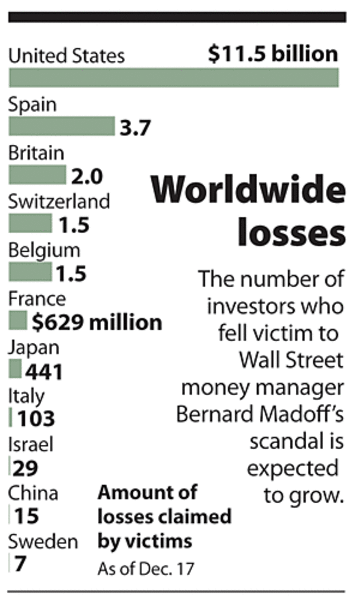Accounting sleuths on the trail of Madoff money
Loading...
| New York
Accounting teams are sharpening their pencils and preparing to pore over spreadsheets in an effort to trace the money at Bernard L. Madoff Investment Securities, which stands accused of perpetrating the largest investment scandal in history.
If the past is any indication, this group of bean counters – call them CSIs with eyeshades – will uncover some assets that can eventually be returned to bilked investors.
Known as forensic accountants, they will comb through the books – in this case multiple sets of books – in a bid to track $50 billion that Mr. Madoff has said disappeared in one giant Ponzi scheme.
"They will be looking for records, fake invoices, cooked books, red flags, anything that doesn't make sense," says Larry Crumbley, the KPMG-endowed professor of accounting at Louisiana State University in Baton Rouge. "They will just be following the computer and paper trail, rather than the DNA."
No one knows exactly how many forensic accountants are available to track money lost to fraud. The Federal Bureau of Investigation has 500 to 600 such accountants whose main job is tracing various types of illegal financial activity, estimates Dr. Crumbly.
Many large accounting firms, too, have accountants who specialize in tracing missing money. Several smaller firms specialize in cases such as the Madoff swindle. Lawyers who represent the investors – charitable institutions, European banks, and individuals who lost their nest eggs, will be hiring some of them.
The work is not easy, say those who've worked to trace Ponzi-scheme money.
"I imagine there will be many, many layers of transactions," says Ken Yormark, managing director and forensic accountant at LECG, consultants in New York. "I would be surprised if we don't find [Madoff] has money someplace other than the US, since he took trips overseas on a regular basis."
Crumbley compares the work to eating a bowl of spaghetti. "You look at a strand and don't know where it starts and ends."
He says it's also like searching for rare coins in a garbage dump using a metal detector. "You will get a lot of false hits."
Forensic accountant Mike Kessler of Kessler International in New York says he usually starts at the end and works his way back to the beginning. "You track the money going backward," says Mr. Kessler.
Mr. Yormark likes to follow "the flow of the funds," which he says usually leads to where the funds have been used.
Yormark used this approach in 1991 when, then at Kroll Inc., he was hired to trace the assets of John McNamara, who was involved in a Ponzi scheme involving General Motors Acceptance Corp. (GMAC). From 1980 to 1991, Mr. McNamara, a developer and car dealer, said he was buying new vans and other vehicles, modifying them, and shipping them overseas for sale. GMAC would fund the purchases of the vehicles.
However, there weren't any vehicles, although McNamara had told GMAC he was buying 40,000 vehicles per month. "He was their best customer," recalls Yormark.
By the time the scandal was revealed, GMAC was out $436 million.
In tracing the assets, Yormark found much had gone into purchasing real estate, plus a gold mine in Nevada. GMAC got some of its money back, but Yormark is not certain how much.
In some Ponzi schemes, however, investors have been fortunate to get a significant amount back. In the late 1990s, Credit Bancorp siphoned $200 million in marketable securities from several hundred investors in a Ponzi scheme. Those investors got back all but $25 million.
In the Credit Bancorp situation, the company persuaded executives to turn over restricted stock, or controlled stock – stock that has to be held years before it can be sold – in return for a dividend. Credit Bancorp used the stock instead to take out loans.
Carl Loewenson, a partner at the New York law firm Morrison & Foerster, hired the accounting firm KPMG to trace the assets and help with complicated tax issues.
"Some of the money we got through an insurance policy from Lloyds of London," says Mr. Loewenson, "and some of the securities were still there."
In the case of the Madoff scheme, accountants expect that sorting out the assets will be time-consuming.
"You will have to take each person's account and follow the money bit by bit," says Roger Nearmyer, president of the Forensic Accountants Society of North America, in Minneapolis. "People will have to prove the investment dollars they put in."
The accountants will also track money that Madoff sent to his investors. If any investors asked for the money because they became suspicious of Madoff's empire, the trustee running what's left of the Madoff empire can ask for the money back, says Loewenson.
"The critical question will be whether the customer acted in good faith," he says. "If you got nervous and said, 'I want my money back,' that is money that could be recovered by the trustee," he says. "But if you got worried, conducted due diligence, and everything turned up OK but you still asked for your money back, then you showed good faith and may be able to keep the distribution."
One thing is for certain: The investors will have to spend hours with forensic accountants and lawyers.
"We don't know everything yet," says Yormark. "And these cases always turn up odd things."





